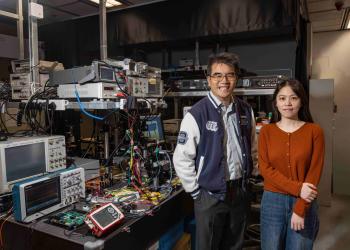Expert Series: Into the Darkest Mystery
Sixty years ago, the whole world was gladly amazed when the first human blasted into space; over the years, hundreds of exploration missions have been deployed to extend our knowledge and understanding of the universe. Of all the space mysteries scientists still hope to solve, black holes remain the strangest and most mysterious phenomena we know so little about.
After decades of effort, scientists finally reached a major milestone when they came face to face with a black hole by capturing its first-ever image in 2019, and a more detailed one earlier this year. The ground-breaking images show the supermassive black hole at the center of Messier 87, a galaxy about 54 million light-years away from Earth. The black hole's mass is equivalent to 6.5 billion suns.
Einstein’s theory wins again
In fact, a few years ago, “if you asked astronomers if there could be a black hole 100 times as heavy as the sun, they would have told you that did not exist,” says WANG Yi, Associate Professor at the Department of Physics. “But now, we’ve discovered them!”
The image of the mysterious structure has provided insight into physics and let us understand more about black holes in many ways. “While there have been alternative theories to describe the strong gravity near the black hole horizons, this photo shows that Einstein’s general relativity wins again. What we see in the picture, everything looks like what Einstein predicted, 100 years ago,” he says. The shape of the black hole’s shadow reaffirms Einstein’s theory.
The image also offers insight into the formation and behavior of black hole structures, such as the accretion disk that feeds matter into the black hole and plasma jets that flow from its center. “Because of the image, we now have a better understanding of the physics of the jet,” he says.
Another “eye” opened
Scientists are also studying gravitational waves, the ripples in space that happen when two bodies, such as planets or stars, orbit each other, as Einstein predicted. The first such event was observed in 2015 when two black holes merged. “It’s a new, independent channel to see the universe. Previously, we were only studying electromagnetic waves which is light. It opened a new era of gravitational wave astronomy,” he says.

“It’s like we previously looked at the universe with just one eye, and now with gravitational waves, we have another eye opened!”
For a very long time, it was thought that capturing an image of a black hole was impossible. The resolution needed is like an astronaut standing on the moon seeing what’s in your plate for dinner on the earth.
“To see distant objects, you need a telescope with high resolution. The larger the lens, or aperture, of the telescope, the greater its ability to gather light, and the higher its resolution. In this case, we needed a lens as big as the earth,” he says.
This was possible thanks to a technology that let different telescopes across the globe work together over years, effectively creating a telescope the size of earth.
Why, you may ask, is it important to research something so far from earth? The image has helped scientists, including Prof. Wang, gain knowledge beyond the study of black holes. Ultimately, they have shed light on how a galaxy is formed, how supernovae explode, and, fundamentally, where we come from, he says.
The value of fundamental physics
In addition, knowing about these celestial bodies is a very strong driver for technological development, says Prof. Wang. To explore the unknown of science – be it something as big as the universe or as small as fundamental particles – we need cutting-edge technology to help, and so the pursuit of fundamental science encourages technological development.
An expert in theoretical high energy physics and cosmology, Prof. Wang published over 90 research papers since 2007 focusing on fundamental physics. Recently, he is working on black holes companioned by pulsars, a type of rotation neutron star that helps inform extreme states of matter. He also works on the early universe, examining questions like what happened right after the big bang? What is the fate of the universe?
But the value of fundamental science is especially evident when you take the long view. “Quantum mechanics was discovered about 100 years ago. At the time, what’s the application? Nobody knew. But now, computer technology relies heavily on the theory of semiconductors, a consequence of quantum mechanics, in particular energy band of condense matter,” he says.
“To see the real impact of our research, we may need to wait for 100 years or more,” he says. “But before waiting for 100 years, now we also appreciate the knowledge about how things work in the most fundamental way. It is important to know, even if we don’t know its applications.”
Curiosity drives progress
Prof. Wang’s curiosity rubs off on many students who have taken his course Modern Physics.
“I really hope that all my students are curious about science, not just about exams and coursework. I want them to be driven by curiosity and willing to find out how things work before going to bed every day,” says Prof. Wang.









